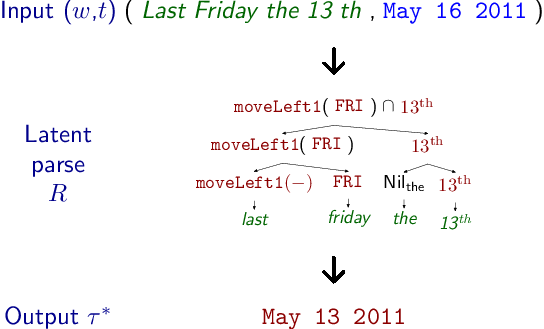Recognizing Time Expressions
Overview
Temporal tagging (or detection) is the task of finding phrases with temporal meaning within the context of a larger document. For example, detecting "the next 2 weeks" in the sentence "I may go to the store in the next two weeks." This can, in itself, be viewed as a special case of Named Entity Resolution, but drawing much more strongly from contextual cues. To illustrate, "may" or "the 13th" are clearly temporal expressions, but "this may be a temporal expression" and "the 13th floor" are not.
Temporal normalization (or resolution, grounding) is the task of mapping from a textual phrase describing a potentially complex time, date, or duration to a context-independent, easy-to-use temporal representation. For example, possibly complex phrases such as "the week before last" are often more useful in their normalized form – e.g., January 1 - January 7. This is in its own right a difficult problem. To illustrate, "the past" and "3 months" each have independent and very different interpretations, yet "the past 3 months" is completely different from either. In addition, temporal expressions are often ambiguous, either in the syntactic structure (e.g. "[last Friday] the 13th" vs. "last [Friday the 13th]") or its pragmatic content (e.g., "Friday" could be either the previous or next Friday).
Software
- SUTime: a rule-based temporal tagger for recognizing and normalizing temporal expressions.
-
ParsingTime: a probabilistic temporal interpreter
for normalizing temporal expressions, with a simple CRF classifier for detection.
Temporal expressions are parsed with a compositional PCFG grammar encoding both combinations over types of expressions (e.g., Duration, Sequence, etc.) and corresponding functions over their temporal values. The system architecture is roughly described in the figure below, illustrated on the sentence "last Friday the 13th" spoken on May 16 2011. The parse tree is labeled with the values of the expressions, however the combination probabilities are over the types of these nodes (e.g., FRI has type Sequence).

Students
Faculty
Papers
- Gabor Angeli, Christopher D. Manning, and Daniel Jurafsky. Parsing Time: Learning to Interpret Time Expressions. NAACL 2012 [pdf, bib]
- Angel X. Chang and Christopher D. Manning. SUTIME: A Library for Recognizing and Normalizing Time Expressions. LREC 2012 [pdf, bib]
Contact Information
Please feel free to e-mail angeli -at- <university> -dot- edu or angelx -at- <university> -dot- edu with any comments or questions.